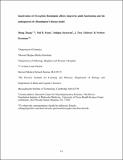| dc.contributor.author | Littleton, J. Troy | |
| dc.contributor.author | Zhang, Sheng | |
| dc.contributor.author | Saraswati, Sudipta | |
| dc.contributor.author | Feany, Mel B. | |
| dc.contributor.author | Perrimon, Norbert | |
| dc.date.accessioned | 2010-07-14T14:51:01Z | |
| dc.date.available | 2010-07-14T14:51:01Z | |
| dc.date.issued | 2009-05 | |
| dc.date.submitted | 2008-04 | |
| dc.identifier.issn | 1754-8403 | |
| dc.identifier.issn | 1754-8411 | |
| dc.identifier.uri | http://hdl.handle.net/1721.1/56290 | |
| dc.description.abstract | A polyglutamine expansion in the huntingtin (HTT) gene causes neurodegeneration in Huntington’s disease (HD), but the in vivo function of the native protein (Htt) is largely unknown. Numerous biochemical and in vitro studies have suggested a role for Htt in neuronal development, synaptic function and axonal trafficking. To test these models, we generated a null mutant in the putative Drosophila HTT homolog (htt, hereafter referred to asdhtt) and, surprisingly, found that dhtt mutant animals are viable with no obvious developmental defects. Instead, dhtt is required for maintaining the mobility and long-term survival of adult animals, and for modulating axonal terminal complexity in the adult brain. Furthermore, removing endogenous dhtt significantly accelerates the neurodegenerative phenotype associated with a Drosophila model of polyglutamine Htt toxicity (HD-Q93), providing in vivo evidence that disrupting the normal function of Htt might contribute to HD pathogenesis. | en_US |
| dc.language.iso | en_US | |
| dc.publisher | Company of Biologists | en_US |
| dc.relation.isversionof | http://dx.doi.org/10.1242/dmm.000653 | en_US |
| dc.rights | Attribution-Noncommercial-Share Alike 3.0 Unported | en_US |
| dc.rights.uri | http://creativecommons.org/licenses/by-nc-sa/3.0/ | en_US |
| dc.source | J. Troy Littleton | en_US |
| dc.title | Inactivation of Drosophila Huntingtin affects long-term adult functioning and the pathogenesis of a Huntington’s disease model | en_US |
| dc.type | Article | en_US |
| dc.identifier.citation | Zhang, Sheng et al. “Inactivation of Drosophila Huntingtin affects long-term adult functioning and the pathogenesis of a Huntington’s disease model.” Disease Models & Mechanisms 2.5-6 (2009): 247-266. | en_US |
| dc.contributor.department | Massachusetts Institute of Technology. Department of Biology | en_US |
| dc.contributor.approver | Littleton, J. Troy | |
| dc.contributor.mitauthor | Littleton, J. Troy | |
| dc.contributor.mitauthor | Saraswati, Sudipta | |
| dc.relation.journal | Disease Models and Mechanisms | en_US |
| dc.eprint.version | Author's final manuscript | |
| dc.type.uri | http://purl.org/eprint/type/Report | en_US |
| eprint.status | http://purl.org/eprint/status/PeerReviewed | en_US |
| dspace.orderedauthors | Zhang, S.; Feany, M. B.; Saraswati, S.; Littleton, J. T.; Perrimon, N. | en |
| dc.identifier.orcid | https://orcid.org/0000-0001-5576-2887 | |
| mit.license | OPEN_ACCESS_POLICY | en_US |
| mit.metadata.status | Complete | |
